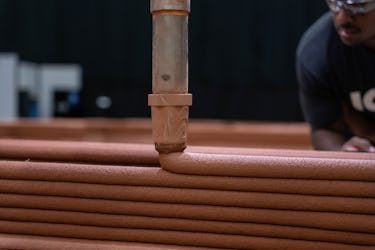Mars Dune Alpha
The 3D-printed Habitat Located at Johnson Space Center in Houston, Texas, Will Aid in Long-duration Science Missions
ICON, developer of advanced construction technologies including robotics, software, and building materials, has been awarded a subcontract through Jacobs supporting NASA’s Crew Health and Performance Exploration Analog (CHAPEA) to deliver a 3D-printed habitat, known as Mars Dune Alpha, at NASA’s Johnson Space Center. ICON’s next-gen Vulcan construction system will complete a 1,700 square-foot structure, designed by world-renowned architecture firm BIG-Bjarke Ingels Group, that will simulate a realistic Mars habitat to support long-duration, exploration-class space missions.

CHAPEA, is a sequence of three one-year Mars surface mission simulations at the NASA Johnson Space Center in Houston. The analog missions will provide valuable insights and information to assess NASA’s space food system, as well as physical and behavioral health and performance outcomes for future space missions. NASA will use research from the Mars Dune Alpha simulations to inform risk and resource trades to support crew health and performance for future missions to Mars when astronauts would live and work on the Red planet for long periods of time.

Life in Mars Dune Alpha will resemble the expected experience for those living in a future Mars surface habitat. Designed by BIG-Bjarke Ingels Group, the layout of the innovative structure is organized in a gradient of privacy. Four private crew quarters will be located on one end of the habitat; dedicated workstations, medical stations and food-growing stations are located on the opposite end, with shared living spaces found in between. Varying ceiling heights vertically segmented by an arching shell structure accentuate the unique experience of each area to avoid spatial monotony and crew member fatigue. A mix of fixed and movable furniture will allow crew members to reorganize the habitat according to their daily needs, as will the customizable lighting, temperature, and sound control – helping regulate the daily routine, circadian rhythm, and overall well-being of the crew.
